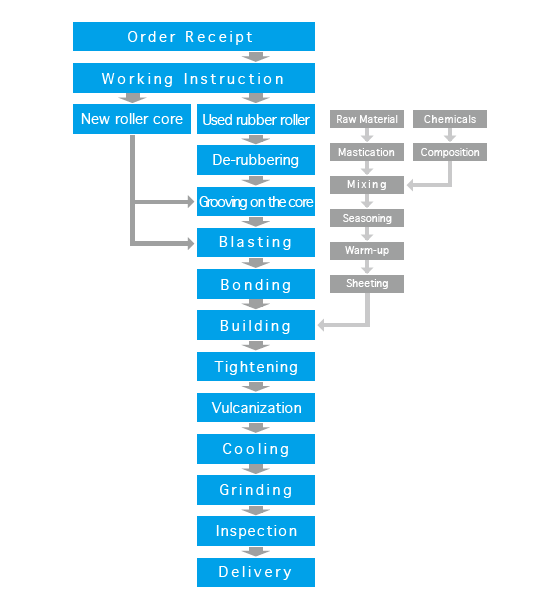HOME > Basic knowledge of Rubber Rollers > Basic knowledge of Rubber Rollers(1,2)
Rubber roller is "a rubber or an elastic material covering the core made of metal or other materials".
Rubber rollers are used in wide application, utilizing its features listed below;
1. High coefficient of friction
2. Quickly returns to its original shape when the shape is distorted.
3. Resistant to chemical substances and protects the roller core and shaft.
4. Prevents damage caused by scratching and bumping.
5. Compensates for small changes in machine precision.
6. It has many special uses;
a. as a dielectric or insulator.
b. as a conductor and semi-conductor on changing the electrical properties
c. as a high-release material (Silicon rubber)
d. with special surfaces (plate roller, grooved roller, helical processing, etc.)
e. others
Manufacturing of rubber rollers, maintaining such characteristics above, requires sophisticated technology and experience. We focus on;
Rollers perform the best when they are properly selected for each application, based on the various conditions outlined above.
There are four methods of manufacturing rubber rollers;

Basic knowledge of Rubber Rollers
Katsura Roller Mfg. Co., Ltd.
5-3-13 Nakagawa Ikuno-ku
Osaka 544-0005 Japan
TEL +81-6-6751-1121
FAX +81-6-6754-4400
HOME | NEWS & TOPICS | PRODUCTS | ABOUT US | ABOUT ROLLERS | JOBS | NET WORK | CONTACT | SITE MAP | PRIVACY POLICY
Copyright © 2010 Katsura Roller Mfg.Co.,Ltd. All rights reserved.